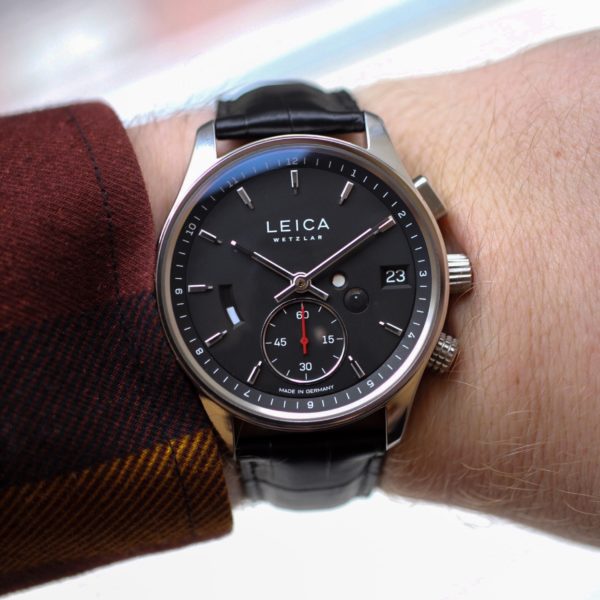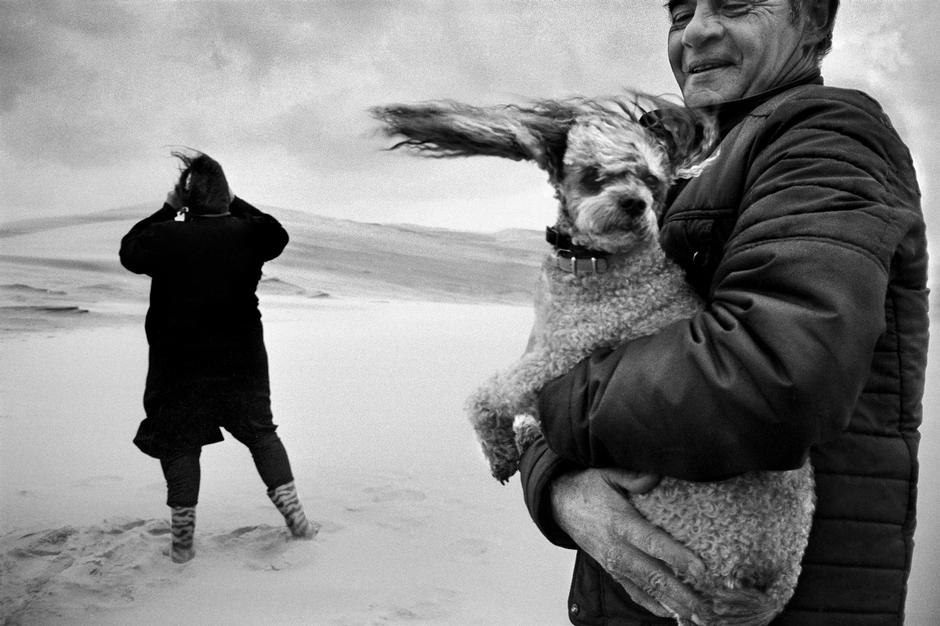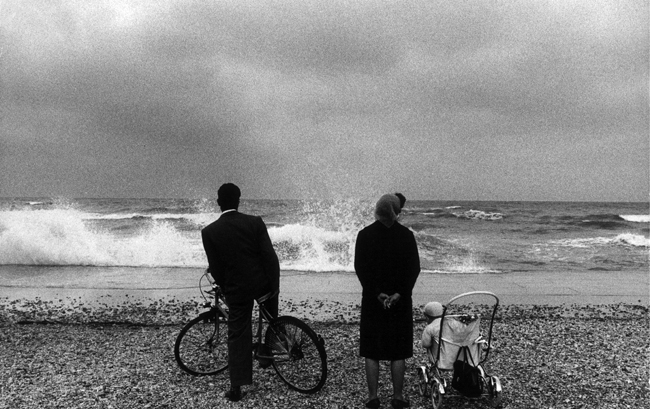
I don’t want a Leica watch. For that matter, I don’t want a Leica camera. I don’t need another Leica. For that matter, I don’t want or need any other camera, whether it’s a Leica, a Fuji, a Nikon, a Sigma or any other shiny new thing that promises to ‘complete my photographic journey.’ I’m not on a ‘photographic journey’, which is stupid adspeak designed by some clever guy in a hi-rise on Madison Avenue to bypass my critical faculties in the interest of selling me his widget. Even if I was, a new camera wouldn’t get me anyplace my current crop of cameras – all bought back then with the understanding that they were going to somehow make my photography better, my journey complete – can’t get me.
I’m sick of technical squabbles and little minds arguing irrelevant issues as if they were a matter of great import. News flash: the camera you use doesn’t matter. Not one fucking bit. The sooner you realize this, the sooner you stop obsessing over whatever new technological gimmick Leica or Nikon or Fuji is selling you, the sooner you’ll open yourself up to what really matters, the things that will make ‘your journey’ better. One thing I have learned is this: equipment is irrelevant. Nobody’s photographs got any better, or any worse, because of the equipment used. It’s like thinking the brand of instruments played on Bob Dylan’s Highway 61 Revisited is the reason it’s a 20th-century American music masterpiece ( it is, BTW, and I will fight anyone who is ignorant enough to claim otherwise (although you can make an argument that Bringing It All Back Home, released just 5 months prior to Highway 61, is even better)).
I’ve been looking at a lot of superb photography recently, enrolled as I currently am in a graduate seminar that requires me to look at photography. I’ve learned an incredible amount about photography in general while studying the specific genre of photography called photojournalism, which is surprising since I thought I basically knew everything there is to know about photography, its history, its theory, its practice. In fact, while I know a lot, in the larger scheme of things I know very little. Sometimes it’s good to be reminded of one’s ignorance; it can motivate you to put aside a lifetime of unconsidered opinion – the common sense ignorance one reflexively absorbs via one’s culture – and actually think about things minus the preconceived notions that inhibit what we think…and what we see.
************

Jean Gaumy, La Dune de Pyla, France 1984
Above is a photo by Jean Gaumey. I’d never seen this photo until a few days ago, when I stumbled across it while on a non-photography related website. Gaumy, while a Magnum member, seemingly isn’t that well known here in the States (or at least, I’d never heard of him, which may be a different matter entirely). It’s just a picture of a guy and a woman and a dog. In this sense, it reminds me a lot of Gianni Gardin’s 1959 photo below:

Both are simple subjects, simply visualized, but both remarkably evocative and powerful. Their power isn’t derived from any technical sophistication – both are shot with film, Gaumy’s looking like he used a 28mm optic, Gardin maybe that or a 35mm – but from an eye sensitive to subtleties of spatial relations, body expression, light, and mood, Both suggest something more than the sum of what’s pictured, the photographer skilled enough to offer an image for the viewer’s imagination. None of this has anything to do with the camera used. All of it has to do with the unique idiosyncrasies of the photographer’s understanding of the world.++
++ And, IMHO, the incredibly evocative power of the traditional B&W film look.

I have been singing the eye-before-equipment song for a very long time. Trouble is, turns out that for a lot of folks the equipment is the “photographic journey” upon which they have embarked. And apparently, they like it that way.
Undoubtedly, some lenses give you perspectives and effects that you can’t get any other way: ultra-wides and reflex lenses spring instantly to mind – but they need to be used with circumspection, otherwise they become a gimmick rather than an aid to whatever one is trying to do. On the whole, I think most of us could get through life with perhaps two or three different focal lengths at the most. The truly great photos we see are not always lens effects dependent: they are great because of the vision of the person who shot them.
Rob
That aligns with my thinking. The purpose of sophisticated photo equipment is to capture the vision in my mind. Less capable gear can limit my ability to capture what I see. That said, there is creativity in using gear with specific limitations and capabilities like view cameras and specific printing processes or films, but that in itself is part of the photographer’s creative vision. I’m OK with someone identifying as a film photographer, or large format photographer, because it defines their vision. I still think calling oneself a Leica Photographer is high order bovine excrement, because it’s a lifestyle brand not a creative vision.
Those are what I call snaps, and they are beautiful, I have a suitcase full of them, quite a few, probably the majority are on cheap colour film, and with a plethora of different cameras and photographers.
These are the photos that were produced by photographers who were not trying to think or be too clever. They saw a pattern or a chink in the light, or they could be mistaken… They might even be compromised by some from of intoxicant, or extraordinarily sad/happy emotion. Nevertheless the button was pressed and the scene recorded, sometimes it works, more often not, but it is not beyond the realms of possibility that had the operator been using a digital camera, they might have been deleted on the fly before their beauty could be appreciated.
Clearly, since the majority of the snaps in my suitcase are made by me, they enter the category of “not very good”, but if the button operator is good, some of these are going to be rather good, since s/he has the latent skills of someone with vision and usually an unthinking ability to fire the shutter “decisively”, and in this snap, they have inhibited the basic animal reaction, and used that learned skill unthinkingly, he said, channelling FM Alexander. 🙂
Whether they are in colour or B&W on the other hand is a conscious thought, often written in stone by the photographer who chooses B&W film, others use colour and convert during scanning in order to get an ability to mess with the b&w tones and shades more easily. Others like Leiter, would have had colour film and produce colour snaps, which he might then paint.
But anyway, it is my contention that these pictures are the result of the unforced errors, if you like, the ones that worked visually.
It would be interesting to know how these particular pictures made it into the public realm? I.e. did the photographer publish, or is there some perfectly innocent reason, like death or a broken relationship? The latter might suggest that the photographer was recording something very personal.
Speaking of personal work, I put “Another Self Portrait” at the top of my list of Bob Dylan masterpieces, just in front of the second disk of “More Greatest Hits”, which includes his collaboration with Leon Russell. The two that you mention are up there too, the man is a one off. He has spent his life thieving other people’s ideas and making them even greater.
His greatest song… “When I paint my masterpiece”, which is quite an appropriate song for a seasoned old snapper…
… and of course who cannot avoid listening in awe as he delivers one of the finest put downs in history, on “Positively Fourth Street”?
As for watches, even though the one that you picture, along with many other examples, represent some amazing human skills in design and engineering, are built to measure something which is a total figment of the human imagination, and pretty unnecessary unless you have agreed to be somewhere and you don’t want to let someone down.
——————————————————————————————————————————————-
Anyway, that is what I thought before I read what the photographer had to say about it….
“I was on a Jeanne Labrune film (La part de l’autre, 1987), with Maïté Nahyr, one of the actresses in Fellini’s film “City of Women” (1980).
I asked her, between two scenes of shooting, to come to the great Dune of Pilat with me.
I was photographing Maïté from afar, up against the wind, in the middle of vast emptiness.
This man and his dog appeared, confidently, passing very close by.
She, them, and me. Close, afar. Different distances that worked perfectly for me.”
So it was still a snap, just a bit more contrived than I first thought.
I guess it needs a certain age and photographic experience to leave G.A.S. behind (I am still fighting…). Another website just sent me to Sugimoto’s unsharp architecture: https://www.sugimotohiroshi.com/new-page-5
His vision was what makes this images so captivating, certainly neither camera nor lens. Not good for camera sales managers of whatever company, but then unknown enough to not be a real danger for sales figures.
Gianni Berengo Gardin’s picture reveals a common flaw with rangefinder users: they cut feet.
Trawl through some of the older stuff in Magnum, and you see it time after time. Even old HC-B wasn’t able always to avoid it. That’s the trouble with tight cropping in camera – unless you use an slr.
That said, I find it hard to believe that any pro ever takes pictures without respecting the professional qualities with which he has made a living. Snap or otherwise, it goes right against the grain to make anything but the best of whatever is there before your camera. Especially with Gardin, who has always been into the creation of books, his first and reputation-making oeuvre being Venice. As such, shooting everything you think is worth the cost of film is not likely to be done without due care to future marketing.
Frankly, I believe that the pro/am mindsets, especially in film days, were miles apart. Reputation was -probably still is – always on the line for the pro, and letting that guard slip very dangerous.
Sugimoto and blur. It has its place as a technique, blur, but after a while it loses its appeal. As a stand-alone image, there is sometimes appeal, but beyond perhaps a triptych… I guess not really.
Incidentally, if anyone here speaks Italian, there are some pretty good interviews on the ‘net with Gardin, including one with a very attractive lady who has an “added interest” technique to her interviewing skills: amazingly distracting shirt buttons. You have to love some aspects of Italian television. Gardin always comes over as modest and totally unassuming. Especially when recounting his first meeting with Ugo Mulas.
Rob
Ooops! I owe Gardin an apology: found the original, and the reproduced version here has been cropped!
He enjoys the theme: a Morris Minor in one shot and a little sports job in another… great background, the sea.
Rob
Hi!
Some off topic comments on Jean Gaumy’s photo. (Your philosophy/photography blog is great, by the way, one of the best!)
Regarding the photograph by Jean Gaumy, the location is misspelled on the caption, a very common mistake even the locals make all the time: the great sand dune is called: Dune du Pilat. Pyla sur mer (where the Dune du Pilat is situated) is the name of an oceanfront district of la Teste de Buch, a municipality in South West France, near Arcachon, my birth place, not far from Bordeaux. Pyla was spelled with a Y by the original land developer in the early years of the twentieth century to make it sound more fashionable and attract investors. Pilat comes from pile, meaning a heap of …sand; the real local name of the great sand dune in Gascon language is Sablonney meaning pile of …sand. Best regards.
I get paid to take photographs, although I wouldn’t call myself a professional photographer (I work in a specialised area of forensics and investigations which necessitates taking highly detailed Macro shots). I use a Canon something, with some hugely expensive lenses and flashes.
I own a beautiful Leica M4, a Nikon F5 and a couple of Pentax MX cameras. I used to shoot the Leica a fair bit, the Nikon has had about a roll of film through it (despite it being my adolescent wet-dream), but my go-to camera is an old Pentax MX, with an F3.5 28mm lens. It is always with me on a day trip or holiday and the images it takes suit my tastes. I reach for that little camera without giving a thought to dragging the other cameras and lenses out- including the Canon.
I’m a digital G.A.S survivor, having never purchased a digital camera myself, but I’ve put some serious money in to film cameras!
I bought an F4s at one stage, and could never get the damned self-loading trick to work first couple of attempts each time a new film was needed. I traded it for a new F3. I thought the F3 had ceased production when the 4 came out, which was why I bought the 4, but I was mistaken. Originally, I avoided the F3 because of the battery. But, my F and F2 really did wear out so I had to buy.
Did your F5 share the loading glitch? Apart from the loading, the F4s thing weighed a ton, but in fairness, it took a lot of extra batteries. That said, perhaps it was heavy only in comparison with my earlier bodies.
Shooting with equipment of a certain known quality of build gives the photographer some assurance of reliable results. Also, equipment makes a difference at the extremes. Some cameras (or more specifically camera types) lead to a kind of image that might not be taken otherwise. I am thinking of panoramic and wide-angle cameras (Widelux, Hasselblad SWC for example). When shooting with one of those, the photographer tends to look at scenes differently. Similarlty, using a low-tech (low- quality) or pinhole camera, the equipment will give the photo a certain look–an intentional, but sometimes unpredictable result.
Well, it is a nice watch…
I’ve been trying to put together a coherent thought stream explaining why I’m content with the kit I now work with. I can’t come up with the ‘hook’ that will catch people and reel them in. The process of buying/selling equipment, reading about what others use and looking at should be a process of discovery and growth. It should also lead to a plateau of contentment (or being comfortable within your skin.)
It’s not a surrender that will lead to mediocre images, but quite the opposite – it should finally free you from equipment insecurity (I gotta have that new _________ because it’ll _________) and allow your eye/brain to really see what’s in front of you and what excites to make a photo that please you.
I don’t totally buy the statement about equipment doesn’t matter: if you are using some camera that creates an impediment for you to show what you see, then it does matter. Brand name is less important than format or film/digital. A badly designed kitchen will not prevent you from cooking, but a well designed kitchen will let you cook with ease.
BTW, I seem to have been dropped from you mailing list. Part of the glitch?
Anyhow, happy New Year to you and all your followers.